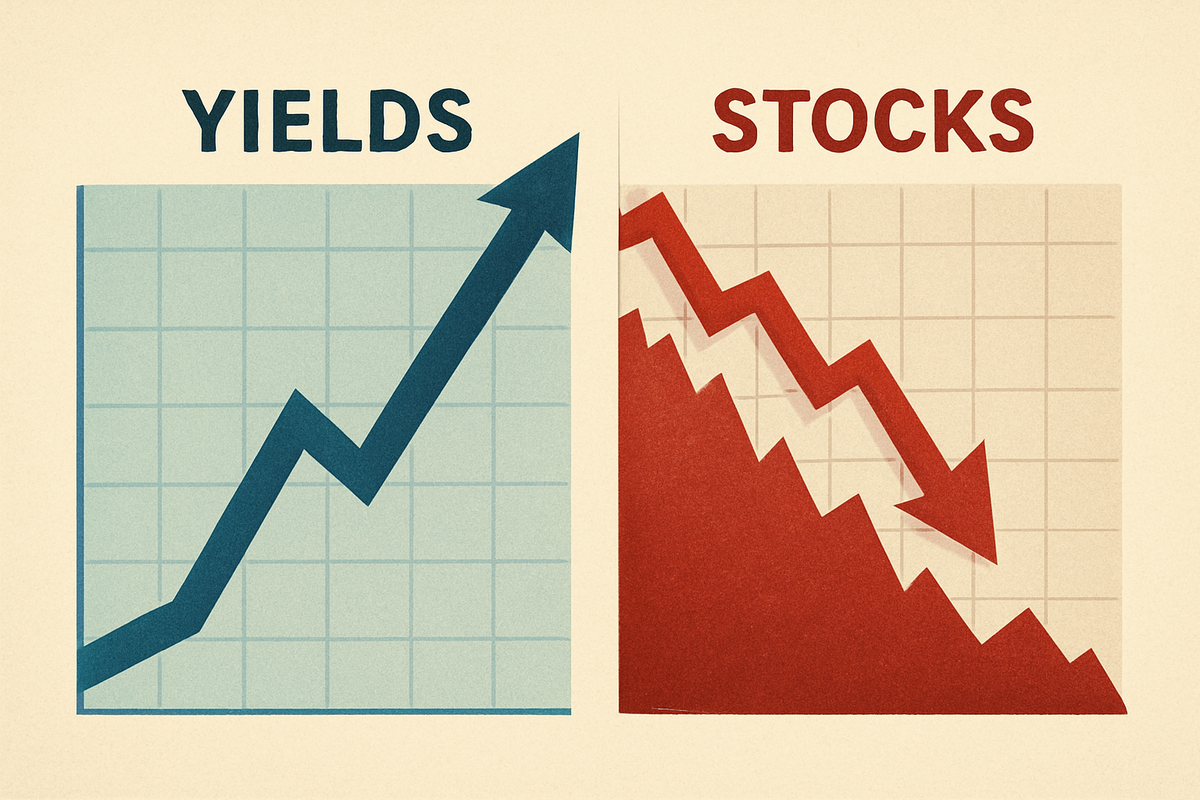
As of November 4, 2025, the financial markets are grappling with the significant impact of U.S. Treasury yields climbing to three-week highs, with the benchmark 10-year Treasury yield hovering around 4.09% to 4.12%. This upward movement in bond yields is sending ripples through the stock market, exerting downward pressure on equity valuations and prompting a noticeable shift in investor sentiment. The immediate implication has been a broad market decline, particularly affecting growth-oriented sectors and smaller capitalization companies, as investors reassess the attractiveness of riskier assets against the backdrop of more competitive fixed-income returns.
This resurgence in bond yields signals a complex interplay of economic factors, including lingering inflation concerns and an uncertain outlook for Federal Reserve policy. The increased cost of government borrowing directly influences corporate financing costs, potentially squeezing profit margins and making future earnings less valuable when discounted at higher rates. For the stock market, this translates into a period of heightened caution and volatility, as market participants recalibrate their portfolios in response to the evolving interest rate environment.
Yield Surge Sparks Market Sell-Off
The recent ascent of Treasury yields to their three-week peaks has been a pivotal development, triggering a discernible sell-off across major U.S. equity indices. On November 4, 2025, U.S. stock market futures indicated significant declines, with Nasdaq 100 futures dropping 1.25%, S&P 500 futures down 0.94%, and Dow Jones futures falling 0.73% in early trading. This sharp reaction underscores the sensitivity of the stock market to bond market movements, especially when yields rise rapidly.
The timeline leading up to this moment reveals a period of fluctuating investor sentiment. While the 10-year yield had seen some decline from 4.4% in November 2024 to 4.1% by November 2025, a recent "runup earlier in the week" pushed yields back to these current highs. This suggests that underlying economic anxieties, possibly related to inflation or the Federal Reserve's future monetary policy, are re-emerging, prompting bond investors to demand higher compensation for holding government debt. Key players involved include global central banks, particularly the Federal Reserve, whose policy statements and economic projections heavily influence market expectations for interest rates. Large institutional investors and bond traders are also significant stakeholders, as their collective actions in the Treasury market dictate yield movements. The initial market reaction has been one of retreat from risk assets, with technology stocks, which had previously benefited from AI-fueled gains, experiencing a notable pullback. This sector, often characterized by high growth expectations and sensitivity to discount rates, is particularly vulnerable to rising yields. Furthermore, earlier in the month, a similar rise in the 10-year Treasury yield to around 4.08% had already led to a sell-off in the interest-rate-sensitive small-cap equity sector, as evidenced by the performance of the Russell 2000 (NYSEARCA: IWM). This indicates a broader market apprehension that has been building.
Corporate Fortunes Diverge Amidst Rising Rate Environment
The landscape created by rising Treasury yields presents a mixed bag for public companies, creating distinct winners and losers across various sectors. Companies with substantial debt on their balance sheets, or those heavily reliant on borrowing for growth and expansion, are likely to face increased financing costs. This directly impacts their profitability and cash flow, making their stock less attractive to investors. Sectors such as real estate, utilities, and certain capital-intensive industries often fall into this category. Smaller companies, particularly those within the Russell 2000 (NYSEARCA: IWM) index, are also acutely vulnerable, as they frequently have less access to cheap capital and are more sensitive to changes in borrowing rates.
Conversely, companies with strong balance sheets, low debt, and robust free cash flow generation tend to be more resilient in a rising rate environment. Financial institutions, especially banks, can sometimes benefit from higher interest rates, as their net interest margins (the difference between what they earn on loans and pay on deposits) may expand. However, this benefit can be offset if higher rates lead to a significant slowdown in lending or an increase in loan defaults. Value stocks, which are often less reliant on future growth projections and trade at lower multiples, may also outperform growth stocks, whose valuations are more sensitive to higher discount rates. Companies with pricing power, able to pass increased costs onto consumers, are also better positioned to maintain profitability.
For instance, high-growth technology companies like NVIDIA (NASDAQ: NVDA) or Microsoft (NASDAQ: MSFT), while fundamentally strong, could see their elevated valuations come under pressure as higher discount rates reduce the present value of their projected future earnings. Conversely, established companies in defensive sectors, such as consumer staples or healthcare, with stable cash flows and lower growth expectations, might be perceived as safer havens. The impact also extends to companies planning significant capital expenditures or mergers and acquisitions, as the cost of financing these endeavors will increase, potentially leading to project delays or cancellations. This environment encourages a shift in investor preference towards companies demonstrating financial prudence and sustainable profitability in the face of higher borrowing costs.
Broader Economic Implications and Historical Context
The current surge in Treasury yields is not an isolated event but rather fits into broader industry trends reflecting an evolving global economic landscape. It signals a market grappling with persistent inflationary pressures and the potential for a more hawkish stance from central banks, particularly the Federal Reserve. This environment challenges the decade-long trend of ultra-low interest rates that fueled significant equity market expansion. The rise in yields can be seen as a market-driven tightening of financial conditions, complementing or even preceding direct policy actions by central banks. This has potential ripple effects on competitors and partners across industries, as increased borrowing costs for one company can affect its supply chain or customer base, creating a domino effect.
Regulatory and policy implications are significant. Higher bond yields could put pressure on governments to manage their fiscal deficits more effectively, as the cost of servicing national debt increases. This might lead to debates around spending cuts or tax increases, which could further influence economic growth and corporate profitability. Historically, periods of rapidly rising interest rates have often coincided with increased market volatility and, in some cases, economic slowdowns or recessions. For example, the early 1980s saw significant rate hikes to combat inflation, leading to a recession but ultimately paving the way for a long period of economic growth once inflation was tamed. Comparing the current situation to these historical precedents, while not a direct parallel, highlights the potential for a challenging transition period as the market adjusts to a new interest rate paradigm. The shift away from near-zero rates means investors and companies must adapt to an environment where capital is no longer as cheap or abundant, fundamentally altering investment strategies and corporate financing decisions.
Navigating the Path Ahead: Opportunities and Challenges
Looking ahead, the trajectory of Treasury yields will remain a critical determinant of market performance in both the short and long term. In the short term, continued upward pressure on yields could sustain market volatility and put further strain on growth stocks and highly leveraged companies. Investors may continue to favor value-oriented stocks, dividend payers, and companies with robust cash flows and strong balance sheets. Potential strategic pivots for companies might include prioritizing debt reduction, focusing on operational efficiency, and delaying non-essential capital expenditures or M&A activities that rely heavily on external financing.
Longer term, if rising yields are a reflection of genuinely strong economic growth and controlled inflation, the stock market could eventually find a new equilibrium, albeit with potentially lower valuation multiples than seen during the era of ultra-low rates. However, if yields continue to rise due to unanchored inflation expectations or concerns about fiscal sustainability, the challenges for equities could intensify. Market opportunities may emerge in sectors that traditionally perform well in higher interest rate environments, such as certain segments of the financial industry or companies that can effectively pass on increased costs to consumers. Conversely, sectors heavily reliant on consumer discretionary spending, which can be impacted by higher borrowing costs for consumers, might face headwinds. Potential scenarios range from a "soft landing" where inflation is brought under control without a severe recession, to a "hard landing" involving a significant economic downturn. Investors should prepare for continued market adjustments and a potential re-evaluation of investment strategies that thrived in the previous low-rate environment.
Concluding Thoughts: A New Era for Investors
The recent climb of Treasury yields to three-week highs marks a significant juncture for the financial markets, signaling a potential shift towards a new era defined by higher interest rates. The key takeaway for investors is the increasing cost of capital, which will fundamentally alter corporate valuations and investment attractiveness across various sectors. The market is moving forward with a clear message: easy money policies are receding, and financial discipline will be paramount.
As we assess the market moving forward, investors should anticipate continued volatility and a re-prioritization of investment criteria. Companies with strong fundamentals, manageable debt, and the ability to generate consistent free cash flow will likely prove more resilient. The lasting impact of this event could be a re-anchoring of equity valuations to more historically typical levels, moving away from the elevated multiples seen during the period of near-zero interest rates. What investors should watch for in the coming months includes further data on inflation and employment, which will guide the Federal Reserve's policy decisions. Additionally, corporate earnings reports will be crucial in demonstrating how companies are adapting to higher borrowing costs and a potentially slower economic growth environment. This period demands a vigilant and adaptive approach to investing, with a focus on quality and resilience.
This content is intended for informational purposes only and is not financial advice






